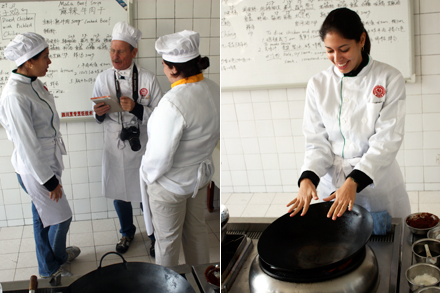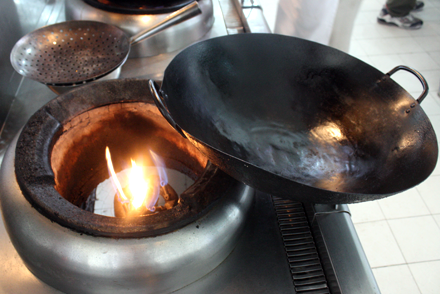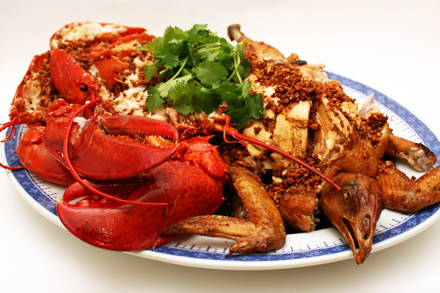There is a mystical allure about the Chinese province of Sichuan (四川) that fascinates me. I’m in awe of its endangered pandas and abundant bamboo forests. The stunning scenery at Jiuzhaigou (九寨溝) dazzles me. And I worship the sophisticated, spicy Sichuan cooking. So you can imagine my excitement when I was offered the opportunity to visit Chengdu (成都), the capital of Sichuan, to observe a cooking lesson offered by the Cooking School in China program.
Organized by Diane Drey, a New York City entrepreneur and Chinese food enthusiast, the Cooking School in China program is a two-week Sichuan cooking class/vacation at the Sichuan Higher Institute of Cuisine. Fuchsia Dunlop helped design the program based on her own experience taking classes at the institute. Dunlop is the author of Land of Plenty/Sichuan Cookery and other Chinese cookbooks. She is also the leading advocate of Chinese cooking in the United Kingdom. The class is offered in English for foreigners interested in learning how to properly utilize indigenous ingredients and cooking methods to reproduce authentic Sichuan food.

Last week I joined the group on the 8th day of the program and spent the entire day with the students. The day was devoted to stir-frying and I was eager to learn whatever I could. Although the school has built a brand spanking new campus about two hours out of the city, our classes were among the last to be held at the school’s old campus within the city limit that is only a thirty minutes ride from where we were staying. It looked like it had not been maintained since the new campus opened, nevertheless the kitchen studio we used was bright and accommodating.
After all the participants seated themselves in the front row, master chef Zeng started his demonstration. Assisted by one senior student of the institute and an interpreter, the chef prepared the ingredients for Sichuan Home-Style Tofu (家常豆腐), Stir-Fried Chicken with Pickled Chili (歌樂山辣子雞), and Cold Mala Beef (麻辣牛肉乾). All three dishes were to be stir-fried so Chef Zeng diligently sliced, cubed and chopped the ingredients. They were eventually displayed in three groups, one for each dish. All the while the interpreter struggled valiantly with the proper English cooking terms to explain the different ingredients and cutting methods. In the end we were able to deduce most of the information by observing the demonstration. One of the students, Soraya Asadi, commented, “I enjoyed learning about ingredients, vegetables and spices. I especially enjoyed discovering interesting vegetables such as lettuce stems.”


The stir-frying demonstration followed and I thought this was the highlight of the class. It was inspiring to see how the master chef calibrated the heat of the roaring burner perfectly for frying the golden brown tofu, for properly cooking the beef strips, and for flawlessly cooking the tender chicken cubes in the flaming wok. Although none of us would be able to return home to such a powerful wok burner, we were all transfixed by how an expert chef can tame a roaring professional burner.

After the demonstration it was time for lunch and we were on our own to wander the side streets around the campus that are lined with little food vendors selling all kinds of local dishes. We had a wide range of food to choose from that included noodles, dumplings, lamb soup and other stir-fry dishes.
After lunch we returned for the afternoon’s “lab” session where the students actually got their hands dirty by reproducing the dishes presented in the morning session. The school staff distributed appropriate ingredients for each student at their stations. The cooking began immediately with chopping and slicing while the master chef and a few other teaching assistants walked around to ensure that the students were doing the right thing. Controlling the heat of the wok burner turned out to be the most difficult part. A few tofu slices were burnt, and some chicken cubes were not seared properly and ended up sitting too long in a pool of less then optimally hot oil. Yet all the dishes came out well and were quite close to what the master chef produced.


Alice de Jong, who attended the program in April, had one suggestion when I wrote and asked her about her experience. She thought “they could improve the quality of the teaching by tasting and commenting more on the students’ dishes.” This limited interaction with the teachers was quite familiar to me, because it was just like my childhood education in Singapore. Students learn by copying examples of the teacher and are mastered through repeated practice. It is evident that this teaching method is what was employed at the institute. I suspect this disciplined practicing regimen works well for the professional curriculum of the institute, although a little more interaction between students and teachers probably could benefit beginners in an amateur program.

Regardless of what the approach is for the class format, by the time we all piled into the van at the end of the day returning to our lodging I’d become very motivated to learn more about Sichuan cuisine. I agreed with fellow student, Esther Ling, who said, “I’m leaving the program with a better understanding of Sichuan cooking, which will make me more enthusiastic in cooking Sichuan food when I return home.” I left with the impression that everyone was truly having a grand time, enjoying cooking and eating well, and returning home eager to practice what they had learned.






Great photos and what an opportunity. I just had mapo tofu at Szechuan Chalet in the UES. 🙂
Kian,
Wow, that is one great class and so many foods, ingredients, and recipes to demonstration and learn. Looks like a wonderful expereince. I would die for one of those wok and burner sets!
Bon appetit!
CCR
=:~)
Interesting. This sounds like it was an amazing opportunity.